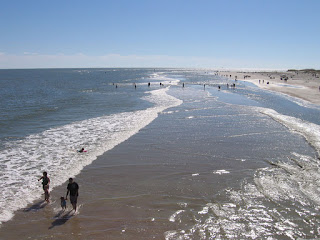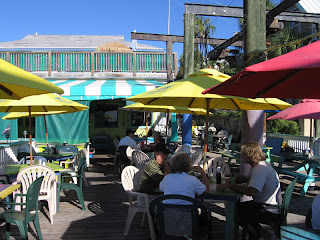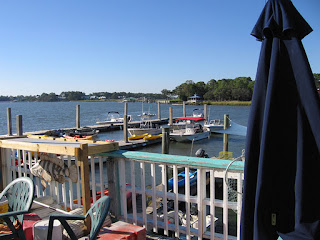Whispering Jesse is now safely slipped at the Delegal Creek Marina on Skidaway Island, southeast of Savannah, Georgia. My crewmate Mike and I sailed her there over the weekend of October 15-16. Mike was a tremendously good sport to join me after last month's storm adventure (
Just a Squall? No, not at All!), especially considering that he had had surgery to repair torn thumb ligaments from a work-related accident the previous week and was wearing a cast on his right hand. He had enough trouble holding a fork; I couldn't imagine him trying to work the boat's many lines.
It should have been a simple trip, just a hundred miles down the coast from Charleston, South Carolina, but things started to go wrong before we even started. The plan called for my parents to pick us up at the Savannah airport on Friday evening and drive us up to the City Marina in Charleston, but Mike and I were on separate flights and his arrived more than an hour and a half late, too late to make the drive up to Charleston. We spent the night at Mom and Dad's house in Savannah instead and left early the next morning.

By the time we thanked my parents for the ride, prepped the boat and checked out of the marina, it was almost noon and the tide had turned. Instead of helping to ease us out of the slip, the current was preventing us from leaving. I needed to back up and to starboard to avoid the boats on the adjacent pier and move out into the seaway, but the current was so strong that it pushed the boat sideways as soon as it cleared the slip, pinning it against the slip's finger pier. I started to wonder when the tide would turn again to free us when two gentlemen who had witnessed our predicament came to our assistance. They helped Mike and me get the boat back into the slip without crashing into the pier and coached us for a more successful exit. I stood on the forward side of the boat's wheel, facing the stern for more effective steering, and put the engine into reverse. The gentlemen released the lines and we motored smoothly backward until we cleared the slip. But as I turned to starboard to miss the catamaran behind us, the current took control and pushed us sideways again, brushing us past the two boats between us and the seaway. Finally free of the pier, I looked for the fuel dock on the other side of the seaway, where we had planned to top off the tank, but there was no way we would have been able to stop there given the current, so we motored on, trusting that the new fuel gauge really was wired backwards, as we suspected, and was reading almost full, not nearly empty.

With the strong current, it felt like we were really motoring through Charleston Harbor, but the knotmeter was registering zero. In the quick month that the boat had been slipped at City Marina, the hull must have picked up enough sea creatures to foul the meter's little spinner. It made me wonder about what else might be growing down there. The anemometer wasn't working either. Mike said that he remembered it registering better than 35 knots during last month's storm, right before it stopped working entirely. Well, at least the depth gauge was still functioning. We would be sailing through shallow waters and would be dependent on it.
As we turned southwest at the second or third buoy after passing Fort Sumter, I looked at my watch and tried to figure out how long it would take us to reach Hilton Head Island, our planned stop for the night. At an average speed of five knots (according to my handheld GPS), for a distance of about sixty miles, we would arrive shortly after midnight. So much for that idea. We would be sailing overnight instead, as we had done sailing from Morehead City to Charleston, after negotiating Chesapeake Bay and the ICW from Solomons, Maryland the month before.

The wind was out of the west, and we were able to cut the engine and sail a near reach for a while in the early afternoon. The jib would have been flapping at that angle, so we flew the Yankee-cut staysail instead. It worked reasonably well for a while, until the wind moved to the south and picked up strength. It seems no matter what tack I take, the wind follows around until it is right off my nose. We fired up the engine again and doused the sails. Soon we were crashing directly into three- to five-foot waves.
We hadn't planned on cooking dinner, but Mike is resourceful. He cut up and fried a sausage we had in the cooler and served it on Saltines. Washed down with a beer, it wasn't too bad, just a little salty. We watched the sun set as we finished our beers and then prepared for the long night ahead. We flipped on the running lights, put on warm jackets and checked our position using my laptop's charting software. We agreed on two-hour watches, and I took the first one while Mike napped below.
There is a line of lighted buoys about five miles off the coast, and we spent the night following them while dodging the many shrimp boats. The boat continued to pound into the waves, which worked loose the electrical connection to the bow's portside running light. I hoped the tri-color on the top of the mast would be sufficient for us to be seen by the shrimpers, who were lit up like daylight as they worked the shallow waters off the coast.

The night passed uneventfully, though sleeping was a challenge due to the boat's up and down motion through the waves. The wind began to wane toward dawn, and I was able to get a couple of hours of uninterrupted sleep. Mike woke me up at six to take the last watch and I took a quick look at the laptop's chart. We were almost directly across from the entrance to Ossabaw Sound. I flipped on my headlamp to check the full-size paper chart for better detail on the depths we would encounter. There were shoals to be avoided, and they were complicated by the fact that high tide was still six hours away.
When I sighted the first lighted buoy inside the sound, I ran down to check the laptop for a position, but it would not come up. I had not planned on running it all night and the battery had run down. I checked the handheld GPS instead, but the detail was woeful. At least it gave us an idea of where we were, along with our latitude and longitude, which we could check against the paper chart, which unfortunately cut off at the edge of where we hoped to pick up Delegal Creek. The northern track through the sound looked like a narrow slot through treacherous shoals, so I opted for the southern track, south of Raccoon Island, which joined up with a dredged channel that is part of the ICW.

We inadvertently steered to a buoy too far ahead, missing the closer one that was way off to port, and hung up on a sandy shoal. Fortunately, the tide was coming in by now and we managed to bump our way into deeper water, but not before missing the entrance to Delegal Creek. I checked the GPS and it looked nothing like what I was expecting. I kept waiting to see an inlet off to starboard, but it never materialized. We continued to motor up the sound, passing marshes, piers and nice waterfront houses, until I spotted the Diamond Causeway, which is the bridge that connects Skidaway Island to the mainland. We had gone quite a ways up the Vernon River and were now way around on the west side of Skidaway Island. I turned a quick one-eighty in the narrow channel and headed back the way we had come, knowing that if we kept the island to port we would eventually find Delegal Creek.
Almost an hour later, across an expanse of marsh, we spotted the observation tower that marks the Delegal Creek Marina. Mike and I looked at each other with expressions that said, "How could we have missed it?" We both figured we were so busy trying to get off the shoal that we didn't look in the right direction when we should have. We rounded past the signs that mark the marina's entrance and warn of a buried electrical cable, motored up the creek and found an empty slip at the marina. I called my parents to let them know we had arrived safely and to arrange a ride, and Mike and I took our time securing Whispering Jesse in her new home.
 Nan and I are fully settled in Grand Junction now, both living and working. I started a new job in January as a programmer analyst with Quality Health Network, and Nan started in the spring as a pharmacy technician at St. Mary’s Hospital. It’s good to know that in our recessed economy, there is always demand in healthcare. Scout has settled into a new routine of his own, spending Tuesdays and Thursdays at doggie daycare, where he romps all day with his dog buddies.
Nan and I are fully settled in Grand Junction now, both living and working. I started a new job in January as a programmer analyst with Quality Health Network, and Nan started in the spring as a pharmacy technician at St. Mary’s Hospital. It’s good to know that in our recessed economy, there is always demand in healthcare. Scout has settled into a new routine of his own, spending Tuesdays and Thursdays at doggie daycare, where he romps all day with his dog buddies. 
 Raising Charlie: The Lessons of a Perfect Dog
Raising Charlie: The Lessons of a Perfect Dog
























































